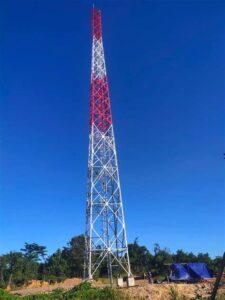Published in Radio Guide Magazine – March 2013
 As many who follow this column know, I recently retired. I looked forward to taking some relaxation time and enjoying myself, as I ease myself into the older years of my life. I planned to open a restaurant, which is still in the works. I intended to continue to help the LPFM service as an advisor/consultant to make sure it stayed on track. I’ve made great progress in detaching myself from many of the day-to-day activities of Nexus Broadcast and the Conexus LPFM Advocacy. Dustin Williams and John Guiteress have taken the reigns at Nexus Broadcast, while Gene Rowley and Alan Mccall are operating Conexus.
As many who follow this column know, I recently retired. I looked forward to taking some relaxation time and enjoying myself, as I ease myself into the older years of my life. I planned to open a restaurant, which is still in the works. I intended to continue to help the LPFM service as an advisor/consultant to make sure it stayed on track. I’ve made great progress in detaching myself from many of the day-to-day activities of Nexus Broadcast and the Conexus LPFM Advocacy. Dustin Williams and John Guiteress have taken the reigns at Nexus Broadcast, while Gene Rowley and Alan Mccall are operating Conexus.
So, with these very capable people taking over my babies, I set off for vacation to sunny Florida! In the meantime, as always seems the case, someone began calling me for help. They had installed their directional antenna system without our help or guidance, and suddenly had given up on trying to do it themselves – they wanted someone down there pronto! Off went Dustin from Nebraska, to help this fellow put his mess of an antenna system back together.
Leo the “Shrink”
This story simply began with a guy who had purchased his equipment from someone else, at a total savings of about $500. Additionally, he found that if he used local guys that would climb the tower for him and “install” the antennas, he could save thousands of dollars. So off he went. Hiring these local guys – surely, if they had the nerve to climb the tower, they must have the brains to install those antennas?
I didn’t hear from him for a few months, until just recently. He had chosen to purchase the equipment elsewhere and hire someone else to install it. Unfortunately, those “someone’s” didn’t support the products after the sale, so he decided to call me – the guy that he didn’t spend any money with – for after the sale support! I felt sorry for him, as I often do for someone in his position. I don’t understand the mentality that expects consulting services from a consultant, for free. It’s like going to a psychiatrist and not expecting to pay for the time you spend with them. After you read this story I am about to tell you, you’ll see why I sometimes do feel like a “shrink.”
Now … the Rest of The Story
The client told me his signal was good out to about 25 miles in one direction, but not very good in a different direction that he wanted to cover. I explained this was a very good signal for a 1 kW directional FM at 100 feet HAAT. But he insisted he should have a better signal out in this other direction, which happened to be the null of the directional system. I told him about the illegalities of removing the parasitic elements, which might resolve the signal problems in the null. He insisted this was the way he wanted to go and suggested that we put up fiberglass rods in place of the metal parasitics. I advised him that this would likely be obvious from the ground, so he suggested painting them. I then explained to him, once again, of the illegal nature of these modifications and their consequences.
He called back in a week and reported that he had removed the parasitics and replaced them with painted fiberglass rods, but the range had not improved in the direction he desired. He indicated that the reflected power had only increased slightly, which was a concern for me, as removing these parasitics should have created an issue. I asked him if he had someone retune the antennas to compensate for the removal of the parasitics; he had not. So, again, the minimal increase in reflected power perplexed me.
 He mentioned that the fiberglass rods looked just like the real metal rods that they had replaced. That got me to thinking about the type of paint he may have used. It turned out that, not only had he used primer, but he followed that with aluminum paint! So this explained why the signal and the reflected power had changed very little. He had replaced the solid metal parasitics with a sort of aluminum plated fiberglass rod!
He mentioned that the fiberglass rods looked just like the real metal rods that they had replaced. That got me to thinking about the type of paint he may have used. It turned out that, not only had he used primer, but he followed that with aluminum paint! So this explained why the signal and the reflected power had changed very little. He had replaced the solid metal parasitics with a sort of aluminum plated fiberglass rod!
Finally, he removed the parasitic completely, and the reflected power increased as expected. Of course the signal didn’t improve much, as the antenna was still tuned for the parasitics – I could not get across to him why it would make a difference if it was not properly tuned.
Next he told me that one of the antennas seemed to be bent and was angling outward – not lined up with the other antenna. He swears the box was not damaged in shipping and the antennas were not dropped at any point. This was a free-standing tower, which tapered smaller toward the top. It became obvious to me that the “bent” antenna was intended to compensate for this slight angle. But even this slight angle, though, wouldn’t have caused the severity of the issues the client was experiencing.
However, the client had reversed the antennas, even though he continued to claim he had followed the manufacturer’s instructions exactly! But it was an indication that the customer had no business installing this antenna system and further problems were likely to be discovered.
Under Pressure – Dustin On The Scene
With the field engineer on the scene, his first observation was that the 1-5/8” line was not pressurized! This was very important for this antenna system, especially since the location was susceptible to a large amount of corrosion due to its locality. Pressurization with nitrogen is very important, as a positive pressure keeps out moisture and corrosives in the air from entering your line. If there is constant pressure from inside the line, nothing can get into it. The nitrogen further insures that no moisture will enter the line from the pressure source – anytime an air-dielectric coax is used, it should be pressurized.
The instructions for this FM antenna system clearly stated that the line was to be pressurized, and even specified the pressure required. The customer apparently felt that this was not important, since he would have had to purchase the nitrogen tank and regulator. Again, trying to save money, without the education to back his decision, had now cost him even more money.
 Our field engineer is still in the field as I write this, so we don’t know the full details. He will be pulling down the entire antenna system to inspect it for corrosion and other damage. Personally I suspect that one of the antennas is actually upside down. This is highly possible since the entire antenna system is currently upside down! So much for following the instructions to a “T.”
Our field engineer is still in the field as I write this, so we don’t know the full details. He will be pulling down the entire antenna system to inspect it for corrosion and other damage. Personally I suspect that one of the antennas is actually upside down. This is highly possible since the entire antenna system is currently upside down! So much for following the instructions to a “T.”
Once the field engineer has fully inspected the system, and reinstalled it with the original metal parasitics, we expect the system to respond properly with enough radiation in the customer’s desired area, to work well enough for his needs. We’ll update you on the progress of this station in a future article in Radio Guide. Qualified = Quality This story accentuates the need to hire properly trained broadcast engineers to install, upgrade, or maintain your radio or television equipment. Trying to saving a few bucks with inexperienced people generally won’t save you any money at all, and clearly, by our example, quite the opposite. In an effort to save money, our client not only paid an unqualified person to initially install the antenna system, but is now is paying the full rate he would have paid the first time to get it right. Additionally, using the wrong people, or doing it yourself, can expose you to severe FCC sanctions and even license revocation. So if you really want to save money, take the time to find experienced and qualified people to help you. But now back to my retirement. As you can see I am still quite busy in a consulting/advisory basis for clients, while also assisting Dustin and John. I keep my hand in things – especially engineering – as it’s difficult for me to let go. I have been working more since my retirement “announcement” than before, it seems. But as I write this article today from my hotel room, listening to the waves caress the warm sands of this Florida beach, I think back on the many years of serving our wonderful customers, and realize I wouldn’t be sitting here enjoying this life without them. For that, my friends, I thank you! Leo Ashcraft is CEO of Nexus Broadcast “Broadcast Outside The Box!”
